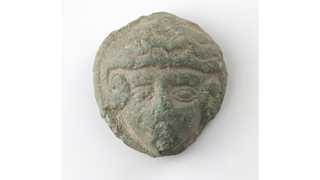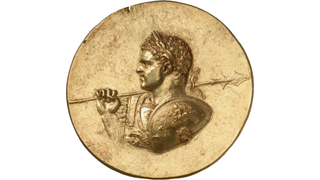'I nearly fell out of my chair': 1,800-year-old mini portrait of Alexander the Great found in a field in Denmark
The miniature bronze portrait depicts Alexander the Great with his wavy hair and crown of ram horns.

Metal detectorists have unearthed a miniature bronze portrait of Alexander the Great on an island in Denmark.
Finn Ibsen and Lars Danielsen made the discovery while conducting survey work in a field outside Ringsted, a city on the Danish island of Zealand, and surrendered the artifacts to Museum West Zealand, Danish news outlet TV2 Øst reported.
The bronze fitting, known as a bracket, measures approximately 1 inch (2.7 centimeters) in diameter, is cast of bronze alloy and includes an engraved portrait of a wavy-haired man wearing a crown of twisted ram horns, according to a statement from Museum West Zealand.
Based on the imagery, archaeologists immediately knew they were looking at the face of Alexander the Great, the legendary leader of the ancient kingdom of Macedon whose empire stretched from the Balkans to modern-day Pakistan by the time he died at age 32.
The piece "has the typical attributes of Alexander the Great, such as his distinct, wavy hair and ram horns," Freerk Oldenburger, an archaeologist at Museum West Zealand, told Live Science. "The image is almost identical to another bracket portrait found years ago that contains the same stylized image."
Related: Ancient tomb really does hold Alexander the Great's father, controversial study claims
That piece, also a metal bracket, was found by a different group of archaeologists in Jutland, Denmark. It was hidden among a stockpile of weapons and likely served as an "ornament worn on a silver shield mount — it was a way to show off," Oldenburger said.
Sign up for the Live Science daily newsletter now
Get the world’s most fascinating discoveries delivered straight to your inbox.
"It's quite a remarkable piece," Oldenburger said. "When it showed up on my desk, I nearly fell out of my chair because it's almost the exact same portrait as the other, but this one is a little more coarse and is made of cast bronze and not gilded silver. The bronze alloy also contains a high lead content and was made using an alloy often found in [Roman] bronze statuettes. It's possible that a statuette was melted down to make this portrait."

While researchers remain unsure of the piece's function, they know that the fitting dates to around A.D. 200 and could have been worn as a "decorative disc for a shield" or as a bracket affixed to a sword belt, according to the statement.
"This was around the same time as Caracalla," a Roman emperor who reigned from A.D. 198 to 217, Oldenburger said. "We know that he was completely obsessed with Alexander the Great and was interested and inspired by him, since he was the greatest conqueror of that time period," he added.
In fact, Caracalla was so enamored of the Greek ruler that he often "dressed with the same style and believed he was Alexander the Great reincarnated," he said. "Caracalla is also the only emperor of his time to be depicted with a shield containing a portrait of Alexander the Great."

Jennifer Nalewicki is a Salt Lake City-based journalist whose work has been featured in The New York Times, Smithsonian Magazine, Scientific American, Popular Mechanics and more. She covers several science topics from planet Earth to paleontology and archaeology to health and culture. Prior to freelancing, Jennifer held an Editor role at Time Inc. Jennifer has a bachelor's degree in Journalism from The University of Texas at Austin.
